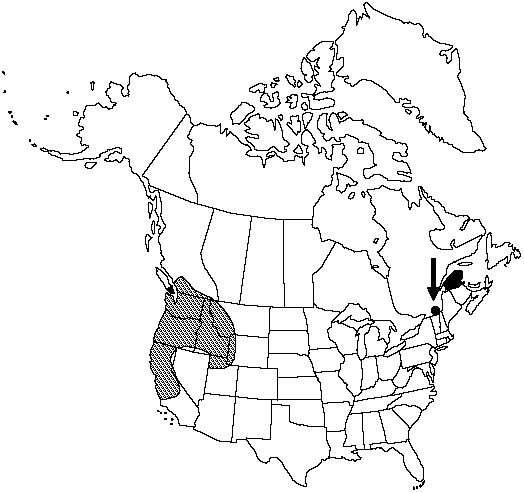Difference between revisions of "Aspidotis densa"
Amer. Fern J. 58: 141. 1968.
Common names: Indian's dream aspidote touffue
Basionym: Onychium densum Brackenridge
Synonyms: Cheilanthes siliquosa MaxonPellaea densa (Brackenridge) Hooker
Treatment appears in FNA Volume 2.
FNA>Volume Importer |
FNA>Volume Importer |
||
| Line 26: | Line 26: | ||
}}<!-- | }}<!-- | ||
| − | --><span class="statement" id="st- | + | --><span class="statement" id="st-undefined" data-properties=""><b>Leaves </b>monomorphic or often somewhat dimorphic, 8–25 cm; fertile leaves more erect than sterile leaves, long-petioled, petioles often 2–5 times longer than blades, fertile blades with more ascending pinnae and narrower segments than sterile blades. <b>Blade</b> 3–4-pinnate, 2–10 cm, somewhat leathery. <b>Ultimate</b> segments linear, 3–8 mm; midrib prominent abaxially. <b>Sori</b> of mature blades continuous along length of segments except at apex; indusia linear, margins with 10–35, shallow, regular teeth or erose. <b>2n</b> = 60.</span><!-- |
-->{{Treatment/Body | -->{{Treatment/Body | ||
| Line 54: | Line 54: | ||
|publication year=1968 | |publication year=1968 | ||
|special status= | |special status= | ||
| − | |source xml=https://jpend@bitbucket.org/aafc-mbb/fna- | + | |source xml=https://jpend@bitbucket.org/aafc-mbb/fna-data-curation.git/src/9216fc802291cd3df363fd52122300479582ede7/coarse_grained_fna_xml/V2/V2_244.xml |
|genus=Aspidotis | |genus=Aspidotis | ||
|species=Aspidotis densa | |species=Aspidotis densa | ||
| − | |||
| − | |||
| − | |||
| − | |||
| − | |||
| − | |||
| − | |||
| − | |||
| − | |||
| − | |||
| − | |||
| − | |||
| − | |||
| − | |||
| − | |||
| − | |||
| − | |||
}}<!-- | }}<!-- | ||
-->[[Category:Treatment]][[Category:Aspidotis]] | -->[[Category:Treatment]][[Category:Aspidotis]] | ||
Revision as of 13:15, 27 July 2019
Leaves monomorphic or often somewhat dimorphic, 8–25 cm; fertile leaves more erect than sterile leaves, long-petioled, petioles often 2–5 times longer than blades, fertile blades with more ascending pinnae and narrower segments than sterile blades. Blade 3–4-pinnate, 2–10 cm, somewhat leathery. Ultimate segments linear, 3–8 mm; midrib prominent abaxially. Sori of mature blades continuous along length of segments except at apex; indusia linear, margins with 10–35, shallow, regular teeth or erose. 2n = 60.
Habitat: Slopes, crevices, rocky outcrops, often on serpentine, sometimes in chaparral
Elevation: 300–3400 m
Distribution

B.C., Que., Calif., Idaho, Mont., Nev., Oreg., Utah, Wash., Wyo.
Discussion
Selected References
None.
Lower Taxa
None.